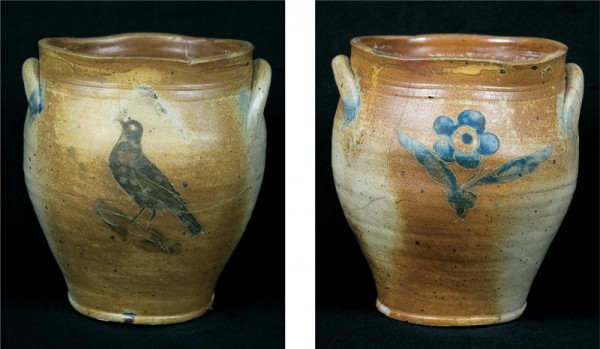
Storage pot (front and back), attributed to William Capron Pottery, Albany, New York, 1800–1801. Salt-glazed stoneware. H. 10". (All objects courtesy of the author; photos by the author.)
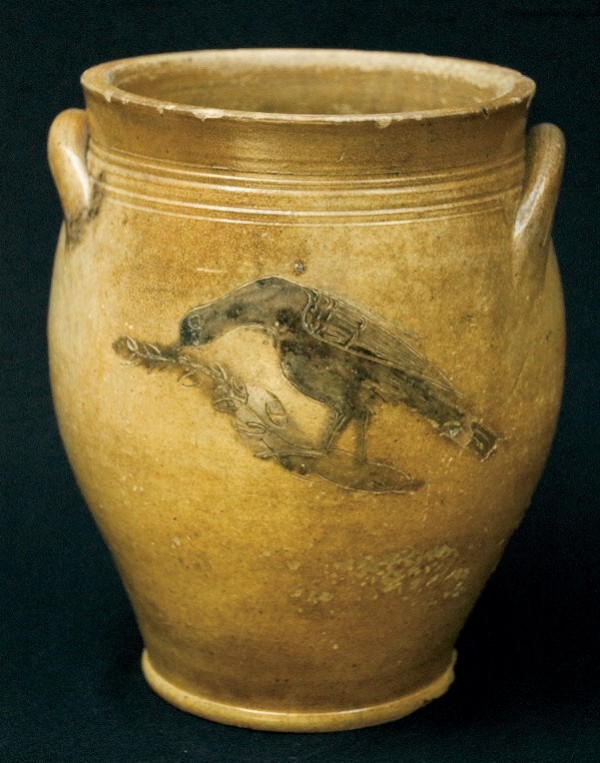
Storage pot, attributed to William Capron Pottery, Albany, New York, 1800–1801. Salt-glazed stoneware. H. 12". The incised decoration, filed with an unusual manganese slip, shows a bird on a branch feeding on berries. The reverse has an incised floral design.
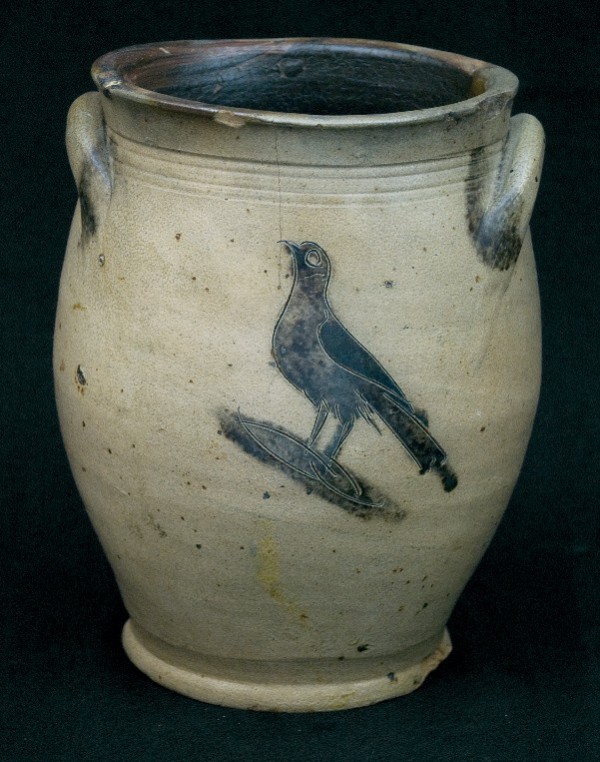
Storage pot, attributed to William Capron Pottery, Albany, New York, 1800–1801. Salt-glazed stoneware. H. 11". On the reverse is an identical bind, filled with the same unusual manganese colored slip used on the pot illustrated in fig. 2.

Jug, attributed to William Capron Pottery, Albany, New York, 1800–1801. Salt-glazed stoneware. H. 15 3/4". Incised bird with cobalt decoration.
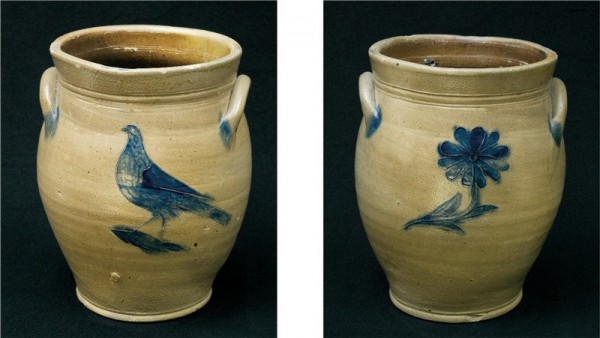
Storage pot (front and back), attributed to William Capron Pottery, Albany, New York, 1800–1801. Salt-glazed stoneware. H. 13". This is one of the most beautiful incised bird decorations found on Albany stoneware; the incised floral decoration on the reverse is also compelling.

Storage pot, attributed to William Capron Pottery, Albany, New York, 1800–1801. Salt-glazed stoneware. H. 12". A three-gallon jar with incised abstract floral decoration. The identical design is on the reverse.
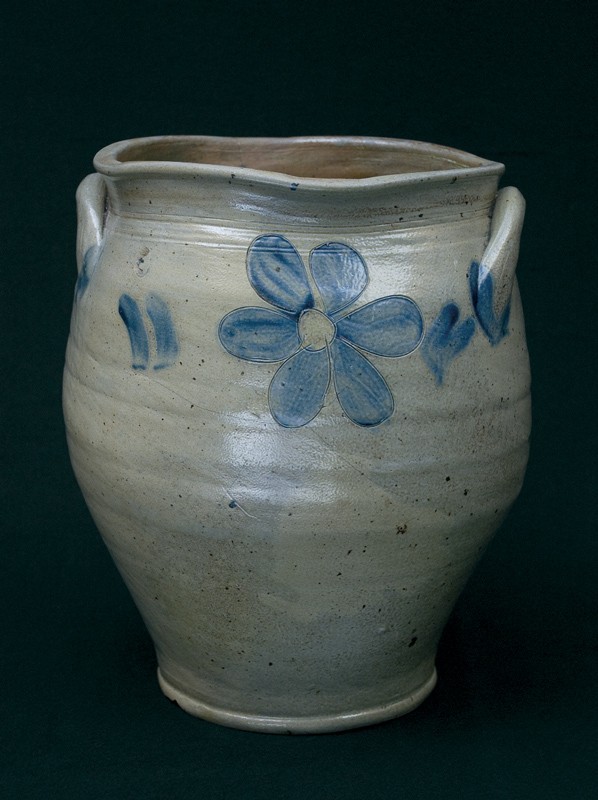
Storage pot, attributed to William Capron, Albany, New York, 1800–1801. Salt-glazed stoneware. H. 15". The same decoration is found on the reverse of this 4-gallon vessel.
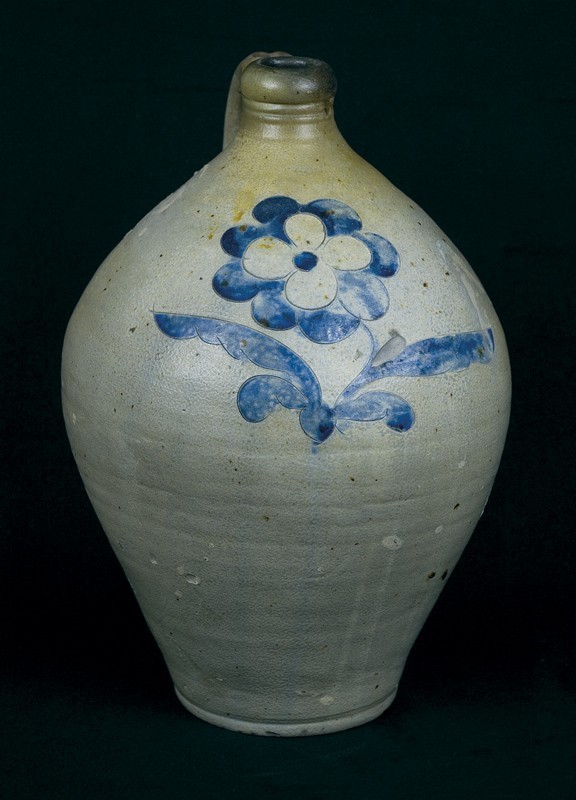
Jug, attributed to William Capron, Albany, New York, 1800–1801. Salt-glazed stoneware. H. 13".
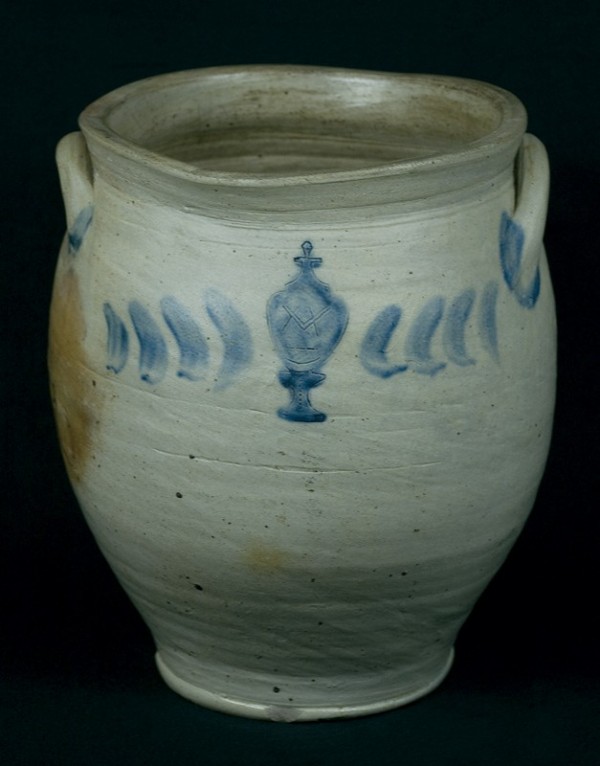
Storage pot, attributed to William Capron, Albany, New York, 1800–1801. Salt-glazed stoneware. H. 16". The impressed decoration of a covered urn is a Masonic emblem.
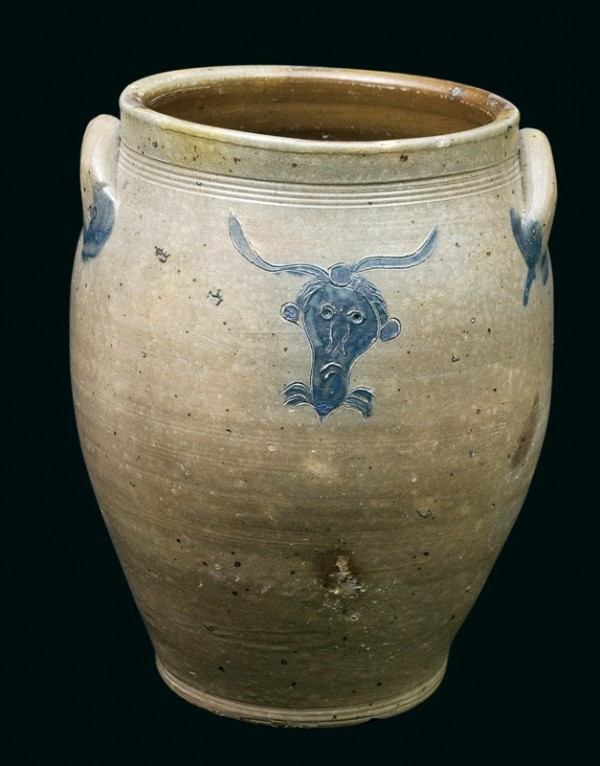
Storage pot, attributed to William Capron, Albany, New York, 1800–1801. Salt-glazed stoneware. H. 13". This jar bears an unusual incised jester decoration, with incised floral on the reverse.

Jug, attributed to William Capron, Albany, New York, 1800–1801. Salt-glazed stoneware. H. 16". The incised decoration shows the body of a seal with a head of a bird, an extremely unusual motif.
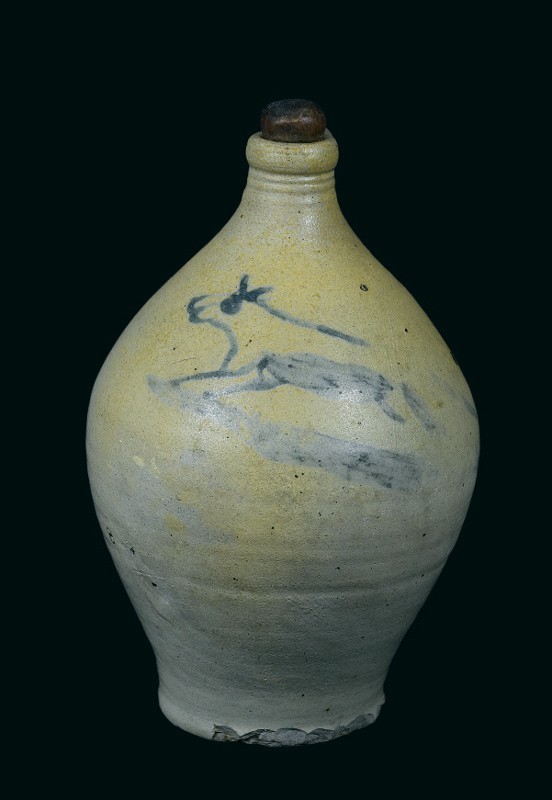
Jug, attributed to William Capron, Albany, New York, 1800–1801. Salt-glazed stoneware. H. 10". This jug displays another unusual decorative slip design, of an animal, perhaps a dog.

Jug, attributed to William Capron, Albany, New York, 1800–1801. Salt-glazed stoneware. H. 15". Mark, above cartouche: VULTURED [to be drunk]. The incised vulture perched on a limb in the cartouche is extremely unusual.
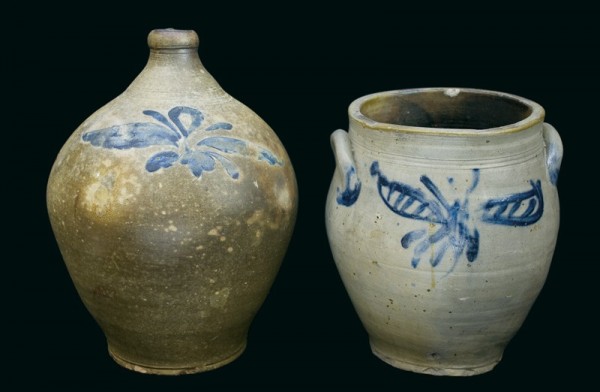
Jug and storage jar, attributed to William Capron, Albany, New York, 1800–1801. Salt-glazed stoneware. H. of jug 14"; H. of jar 12".
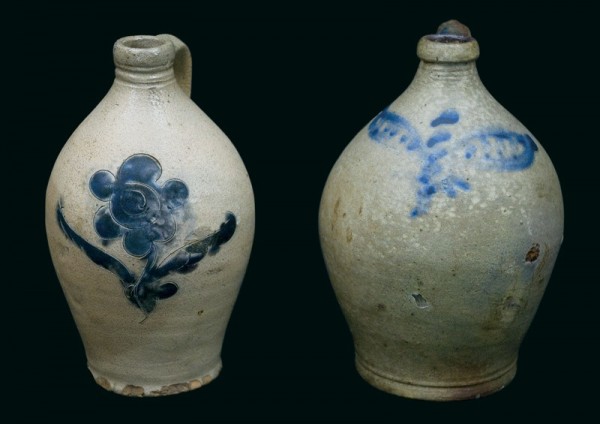
Jugs, attributed to William Capron, Albany, New York, 1800–1801. Salt-glazed stoneware. H. of each 7".
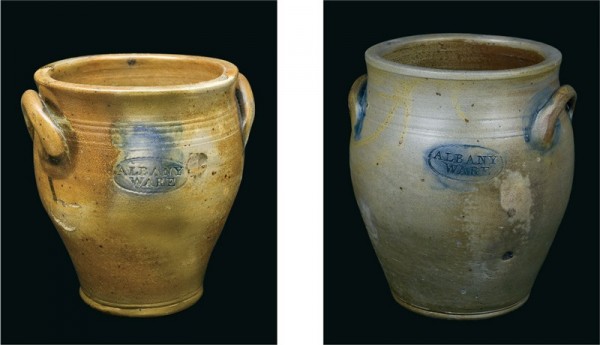
Storage pots, William Capron, Albany, New York, 1800–1801. Salt-glazed stoneware. Left: 1-gallon jar. H. 10". Right: 2-gallon jar. H. 13". Impressed on both sides of each: ALBANY / WARE.

Detail of the 1-gallon jar illustrated in fig. 16.
More than twenty years of study and analysis have led me to believe that a particular group of unmarked stoneware can be attributed to the pottery of William Capron (1763–1823) of Albany, New York. This identification process began in 1985 with the purchase of an early two-gallon stoneware pot from a small country auction in Vermont (fig. 1).
Ovoid in shape, the pot has rolled handles that rest lightly and unevenly on its shoulder. The vessel is heavy, with thick walls. It has incised tooling one inch below the slightly flared rim and a footed base. The pot is decorated on one side with an incised bird, on the other with an incised flower; both decorations are nicely filled with cobalt.
Over time, I found other stoneware pots that shared many of the characteristics of my Vermont acquisition: heavy, ovoid, and thick-walled; rolled handles on the shoulder; flared rim and footed base; incised decoration on both sides, filled with cobalt varying in hue from bright blue to deep blue-black. Most were found in the Hudson River Valley and none bore a potter’s mark or pottery name.
The decorations on these pieces vary. Many are incised birds, among them a likeness of the Hudson Valley dove, and other unusual bird motifs (figs. 2-5); others show flowers with large petals or other abstract florals, all filled with cobalt (figs. 6-8). Impressed Masonic decorations are represented, along with more unusual motifs, such as incised or brushed folk art renditions of human figures and animals (figs. 9-13). Brushed cobalt decorations include florals and abstract designs, as well as simple brushstrokes that surround the vessel’s circumference (figs. 14, 15).
Because of the very early form and incised decorations of these jugs, numerous stoneware scholars and publications have attributed similar pieces to New York City. Many early New York City potters brought their trade with them from the Rhineland region of Germany, where salt-glazed stoneware had flourished as an art form beginning in the sixteenth century. As a result, early New York City pieces circa 1800–1810 tend to be very well crafted. The potters were skilled and knowledgeable in firing techniques, and their vessels exhibit little warping. Germanic influence is clear in the bulbous forms and ringed necks, and the execution of the decorations, which are very artistic in nature, shows great expertise.
New York pieces have free handles (that is, pieces in which the upper edge and the side of the handles do not touch the body), footed bases, and flared rims. Various decorative techniques were employed, among them incising, brush work, and use of the coggle wheel. Incised and impressed decorations are carefully filled with cobalt. Early New York City potters used a fine, high quality of clay from the Amboy region of New Jersey, resulting in relatively few surface firing imperfections.
The examples under discussion here, however, are too heavy and their walls too thick to have been made in New York City. Their handles are not the freestanding type typical of early New York City pieces but, rather, are rolled, round in form, and touch the surface of the pot. These pieces were made with local clay, which contained more impurities and caused many more firing imperfections on the surface. More of the vessels are warped, indicating that the potters were less skilled and knowledgeable about firing techniques. In addition, although these early pieces often have incised decorations, the cobalt is not as carefully applied. Taking these differences into consideration, it was determined that these comparatively crude vessels could not have been made in New York City.
If not New York City potters, then, what is the source of this unknown stoneware? One consideration was the pottery of Paul Cushman (active 1806–1833), located in Albany, New York. However, even though Cushman pieces have very strong similarities in overall form—shape, handles, and wall thickness—none that I know of has the same type of bird or floral decorations. Some of the marked Cushmans have impressed decorations made with coggle wheels, but no coggle decorations have been found on the unmarked early pieces under investigation. Moreover, very few marked Cushman pots are decorated on both sides. These factors were sufficient to look elsewhere for the maker.
A major breakthrough came with the discoveries of a one-gallon and a two-gallon pot with the impressed mark “ALBANY / WARE” that both bear a strong resemblance to the unidentified group of early stoneware (figs. 16, 17). It is generally accepted by collectors that stoneware so marked was made at the William Capron pottery, believed to have been in existence from 1800 to 1801. Although little is known about Capron’s pottery, an advertisement placed in the Albany Register from August 5, 1800, through March 13, 1801, helps pinpoint his years of operation.
When examples of Capron’s marked vessels are compared with the unmarked pieces under discussion, numerous shared characteristics are evident. All are ovoid in form, with occasional firing irregularities. Most of the rims are flared outward at a slight angle, and about 1–1 1/2 inches below the rim all have incised lines circling the vessel, although the number, size, and width of the lines vary. The handles of the pots are always rolled and round in form and sometimes were placed unevenly on the pot; the terminals were often highlighted with brushed cobalt. Similarly, all of the jugs have incised rings on the neck, which vary in number, width, and size. The rolled jug handles are flattened underneath, ribbed on the top, and some were touched with cobalt where they are attached to the body of the jug. The jugs and pots both have an incised ring near the bottom, above a slightly raised footed base. The exterior color of the stoneware includes various shades of beige, brown, and gray. The clay contained many impurities, which caused stone pops and other kiln firing imperfections that can be seen on the surface of the pieces.
Based on this analysis and the comparison of form, potting techniques, decorations, and color of clay used in the production of the unknown group of stoneware and the group of marked “ALBANY / WARE,” along with the information available on the mark and dates of the William Capron pottery, I have concluded that this large group of early, unmarked stoneware can be attributed to Capron’s pottery. Further, given the large number of marked Cushman pieces that resemble these early unmarked pieces in overall form, it is my opinion that William Capron or one of his potters worked at the Cushman factory.[1]
The great number of questions and mysteries surrounding the history of America’s regional stoneware production has, I believe, been reduced by one.
William Ketchum Jr., Potters and Potteries of New York State, 1650–1900, 2nd ed., rev. (Syracuse, N.Y.: Syracuse University Press, 1987), p. 147; Warren Broderick and William Bouck, Pottery Works: Potteries of New York State’s Capital District and Upper Hudson Region (Canbury, N.J.: Associated University Presses, 1995), p. 34.
